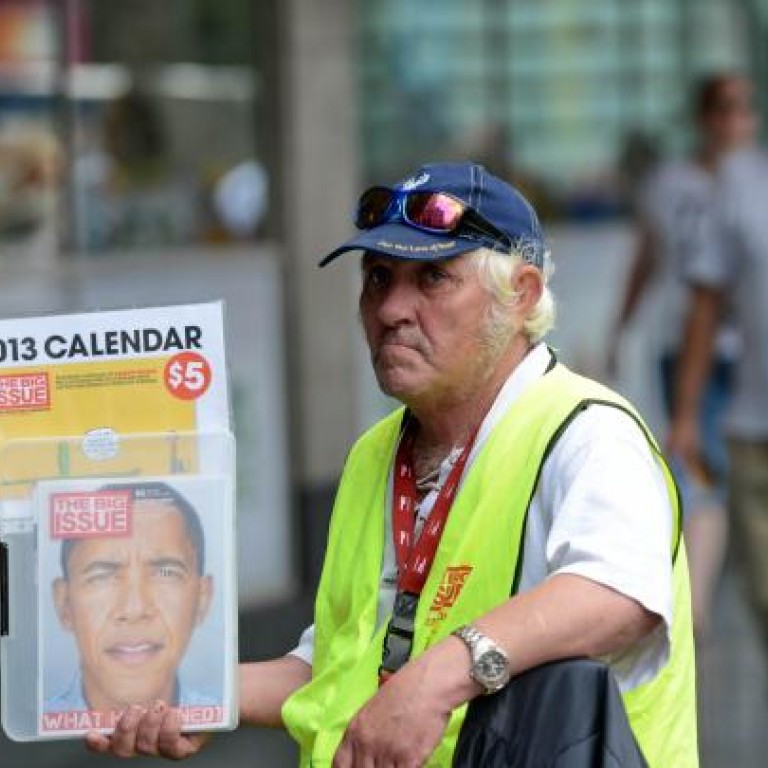
Australia jobless rate unexpectedly falls
Australia’s unemployment rate unexpectedly dropped in November as a labour market driven by mining-industry hiring weathers a weaker global economy, sending the local currency higher.
The jobless rate fell to 5.2 per cent from 5.4 per cent in October, the statistics bureau said in Sydney today. That compares with the median estimate for unemployment of 5.5 per cent in a Bloomberg News survey of 27 economists.
The number of people employed advanced by 13,900, compared with the consensus forecast for no change.
The data underscore the strength of the world’s 12th- largest economy, which expanded at an annual pace of 3.1 per cent last quarter driven by resource investment.
Reserve Bank of Australia Governor Glenn Stevens lowered interest rates by a quarter per centage point this week, bringing to 1.75 points the cuts since Nov. 1 last year as he seeks to revive industries outside mining, where investment is expected to peak next year.
“The labour market is still fairly tight,” said Annette Beacher, head of Asia-Pacific research for TD Securities Inc. in Singapore. “The economy is still in terrific shape and therefore we can expect to see the Aussie dollar remain well over parity into 2013 and the RBA’s work is nearly done.”
The local dollar traded at US$1.0469 at 1:03 p.m. in Sydney, compared with US$1.0447 before the jobless numbers were released. While the currency has risen 7.9 per cent since June 1 and hurt industries exposed to international goods, some are weathering the competition.
Clothing company Cotton On will expand its headquarters in Geelong, Victoria, and create 500 new jobs, the state government said last month. Victoria Premier Ted Baillieu said on November 16 that the new jobs would increase total employment at Cotton On to about 1,300 and ensure business operations remain in the region.
The jobless report showed the number of full-time jobs declined by 4,200 in November, and part-time employment rose by 18,100, today’s report showed. Australia’s participation rate, a measure of the labour force in proportion to the population, dropped to 65.1 per cent in November from a revised 65.2 per cent a month earlier, it showed.
The central bank’s board lowered the overnight cash-rate target six times since Nov. 1, 2011, to 3 per cent. Still, the number of Australian construction jobs fell by 70,200 to 978,000 in the 12 months through August. Mining employment gained by 44,600 over the same period to 271,000, according to government figures.
Unemployment in Western Australia, center of the nation’s mining bonanza, dropped to 4.1 per cent last month from 4.6 per cent a month earlier, the report showed. The rate in Queensland, another resource-rich state, fell to 6 per cent from 6.1 per cent, it showed.
The result contrasts with help-wanted notices that dropped for an eighth straight month in November, sliding 2.9 per cent, an Australia & New Zealand Banking Group Ltd. report showed this week. General Motors Co.’s Holden unit said last month it will cut about one in 13 jobs at its main plant in Adelaide as the strong local currency and increased car imports crimp sales.
“Unemployment will probably rise from here,” Scott Haslem, chief economist for Australia at UBS AG in Sydney, said in a research report after the release. “Whatever the outcome ahead, today’s data certainly suggests the RBA is on hold at 3 per cent for more than a couple of months.”
Resource investment to meet Chinese demand and foreign investment funds seeking a haven spurred gains in the local currency, which closed above parity with the US dollar for all but 23 days this year.
BHP Billiton Ltd., the world’s biggest miner, in August decided to delay approval of an estimated $33 billion expansion of the Olympic Dam copper, uranium and gold mine.
Fortescue Metals Group Ltd., Australia’s biggest iron ore producer after Rio Tinto Group and BHP, said in September it’s cutting its full-year capital spending forecast by 26 per cent to $4.6 billion.
“Looking further ahead, with the labour market softening somewhat and unemployment edging higher, conditions are working to contain pressure on labour costs,” Stevens said in the December 4 statement announcing a 25 basis point reduction in the cash rate to 3 per cent.

